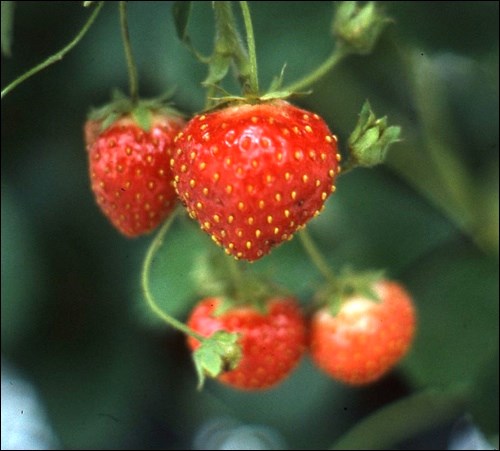There is no comparison between the taste of fresh strawberries from your own garden and those that have earned air miles en route from California or Mexico. Especially now as the local season started a few weeks ago and runs until September. And growing your own is not difficult.
Begin with the site – full sun with shelter from the wind. Avoid low-lying areas that are susceptible to frost damage. Strawberries do best in a well-drained soil that has been cultivated to 10-12 inches and then generously amended with organic matter such as compost or well rotted manure.
Plant them in mid-spring, being careful not to allow the young plants (especially their roots) to dry out. Place them 12 inches apart within the row with the rows three feet apart. The mid-point of the crown should be level with the soil surface. Do not cover the crown with soil. Gently firm the soil around the roots and water thoroughly to the depth of the root system and beyond.
Mulch with a few inches of clean straw beneath the foliage and extending about eight to 10 inches on either side of the plants. Do not cover the crown with mulch. The straw mulch will reduce weeds, maintain soil moisture and keep the foliage and fruit clean. As well, it will prevent the splash of soil borne disease organisms, such as grey mould (Botrytis), onto the fruit.
Control weeds between rows with either additional mulch or the business end of a hoe. Apply one inch of water weekly, more if extremely hot or windy. Once established, side-dress the rows with a fertilizer such as 16-20-0 applied according to label directions.
Ripe and ready strawberries are completely red. No further ripening will occur once they are off the plant. Fruit is best picked in the early morning while it is still cool. Leave the “cap” and stem on the berry. Avoid harvesting after a rain or irrigation. Wet fruit deteriorates more quickly. If disease is present, you’ll be spreading it as you move from plant to plant. Refrigerate the berries as soon as possible.
Young plants are generally more productive than older plants. To maintain the youth of your patch, direct daughter plants (at the end of rampant runners) back into the row – they’ll root on their own. To prevent the row from becoming a solid mat, remove older plants, mother plants at the end of the season.
Winter protection is needed where snow protection is not dependable. Cover the plants with four to six inches of weed-free straw once temperatures drop to -5 C for several nights running and before -7 C hits. Remove mulch in early spring once danger of frost is past or the plants begin to actively grow.
Whereas your grandparents had limited choices, three types of strawberries are now commonly grown on the prairies — June-bearing, everbearing and day-neutral.
June-bearing varieties produce a single crop each year during a three- to four-week period in late June and July. Once fruiting is complete, the plant sends out runners that produce additional plants.
Everbearing cultivars generally fruit twice a year, from late June to early July and again in late August. The fruit is generally softer and less abundant than June-bearers or day-neutrals.
Day-neutral cultivars do not depend on day length to produce flower buds, therefore, they produce fruit throughout the growing season. Production is generally heaviest June and then in August and September. Their total production is greater than the other two types. And they generally produce a good crop their first year.
There are many varieties to choose from. Check with your local nurseries and GardenLine (see below) for recommendations.
— Sara Williams is the author of the newly expanded and revised Creating the Prairie Xeriscape; Gardening, Naturally: A chemical-free handbook for the Prairies; and the Saskatoon Forestry Farm Park & Zoo: A Photographic History. Sara will be leading a garden tour to Great Britain in May, 2016 and co-leading, with Melanie Elliot, a tour of Fauna and Flora of Iceland in July, 2016. Call Ruth (1-888-778-2378) for more information.



